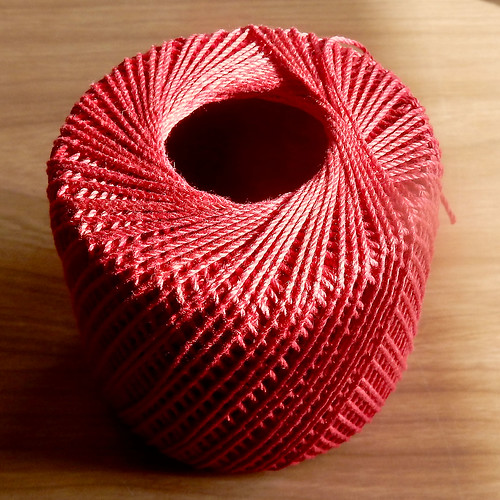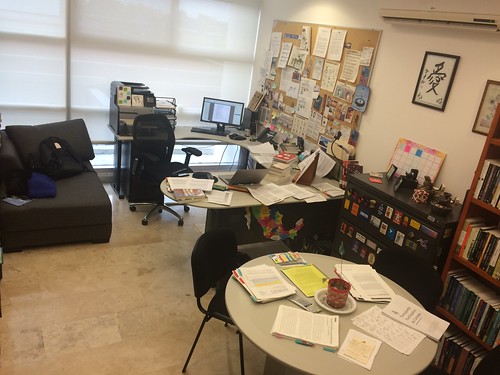Two scholars I really respect and whose writing I follow quite meticulously are Dr. Pat Thomson (University of Nottingham) and Dr. William Germano (The Cooper Union). Both of them have independently developed and/or promoted ideas on how to make your full argument coherent, cogent and readable. When I first started editing my doctoral dissertation to make it into a book, I read Dr. Germano’s book “From Dissertation to Book”. I also have read a lot of the work that Dr. Thomson has written, in particular her coauthored books with Barbara Kamler. I have written before about her “Strategies to Publish Peer Reviewed Journals” here on my blog.
The Red Thread is (from what I’ve read here, here, here, and here) a Nordic/German concept. The intellectual trajectory of a paper or a book, usually book. The overall argument. The global narrative.
As a side note and a funny anecdote: my Mom is a social scientist (a retired professor of political science and public administration, with a PhD in government). I remember when she used to tell her students: “you need to find the conductive thread” (“hilo conductor”, in Spanish). I was a chemical engineer at the time, so I was like “well, unless you’re talking electricity, I have no idea why you would want a conductive thread”. Once I started taking business strategy and later, social science (political science, human geography, history, economics) courses, I realized what she meant).
That in addition to Dr. Thomson and Dr. Germano’s suggestions on The Red Thread and The Throughline, I could glean some insight as to how OTHER scholars develop their own red threads and throughlines.
I imagine it’s a similar process to the one I develop with the GDN.
— Dr Raul Pacheco-Vega (@raulpacheco) January 20, 2020
… other books.
There’s a number of books that I’ve read in enough depth that I could quickly glean their Red Threads/Throughlines. I am super, super, super busy this week, but I’m going to try to carve some time to go over those and see if I can offer some pointers.
— Dr Raul Pacheco-Vega (@raulpacheco) January 20, 2020
In this blog post I offer these generally-applicable pointers for book-manuscript-style dissertation writers, 3-papers thesis writers, undergrad/masters, and post-PhD book writers. To be honest, I feel that reading Thomson, Germano and Pacheco-Vega would suffice, but it never hurts to have the general patterns drawn out and spelled out as much as possible.
Discerning The Red Thread (Throughline/Global Narrative) from edited volumes and single/multiple author(s) books
This Twitter thread shows how I discerned these books’ RT/T/GN.
… posts on “how to read a single author/multiple authors book” https://t.co/bR7IdNMkvo and on “how to read an edited volume” https://t.co/T8UCA1qSHm
Well, a key trick of the research trade, especifically of reading academic books, is knowing where to find information you seek.
— Dr Raul Pacheco-Vega (@raulpacheco) January 21, 2020
… the introductory chapter.
If you read a book’s table of contents and you interpret it the same way you would a research paper outline (key topics I’m going to cover), it should yield The Red Thread/Throughline https://t.co/1zazngNo3E
Makes sense, right? Let me show you.
— Dr Raul Pacheco-Vega (@raulpacheco) January 21, 2020
My underlying rationale for searching table of contents and introductory chapter (& concluding chapter) is the Rule of Threes in Writing:
a) Tell me what you’re going to say (introductory chapter)
b) Say it (full manuscript)
c) Tell me what you said (concluding chapter)
From the above, it should follow that reading a book’s table of content, introductory and concluding chapters should give you at the very least AN IDEA of what the Red Thread/Throughline is. Remember, this is the MAJOR argument. If your book were a fish, the Throughline is he fishbone. If you were to antropomorphize your book, the Throughline or Red Thread is the spine. The one thing keeping everything together, tying everything together.
The following Twitter thread shows how to discern the Red Thread/Throughline/Global Narrative off an edited volume.
This is the table of contents for @OsmanyPorto @ceciliaosoriog @sergemont and Da Silva Leite’s edited volume. Reading the table of contents we can infer that the book is about non-orthodox transfer. Usually we think of policy transfer as from countries from North to South pic.twitter.com/G8m6wZaTGu
— Dr Raul Pacheco-Vega (@raulpacheco) January 21, 2020
Luckily, the editors give us the main argument of the book (the Red Thread or Throughline) right in the introductory chapter under (you guessed) the heading: “The main argument” (thanks, y’all!)
This makes my life and yours easier. From the table of contents and introduction pic.twitter.com/RkAXmnWPqO
— Dr Raul Pacheco-Vega (@raulpacheco) January 21, 2020
Not every book is designed in the way Osmany, Cecilia, Sergio and Cristiane designed theirs, making the Red Thread/Throughline very, very, very clearly explicit. Others need you go to on a fishing expedition and read more of the book. But in this case, you can read the intro.
— Dr Raul Pacheco-Vega (@raulpacheco) January 21, 2020
I’ll continue this thread with two other examples, but I strongly believe that this particular book is a great example of how you clearly present your Red Thread (your argument) to your reader, even as an edited volume (you should read it too!) https://t.co/LNTfichgzo
— Dr Raul Pacheco-Vega (@raulpacheco) January 21, 2020
Now, let’s do the Red Thread/Throughline/Global Narrative of a multiple-authors book.
Let’s look at the table of contents and introductory chapter.
At the very core, Thirst is about the two main strands of water marketization: commodification and privatization, and how activists fight both of these types of market-properties’- imprinting on water. pic.twitter.com/zZ0iV71S59
— Dr Raul Pacheco-Vega (@raulpacheco) January 26, 2020
How do *I* develop my own book/thesis/dissertation’s Red Thread/Throughline/Global Narrative?
Below, I outline Thomson’s, Germano’s and my approach to developing the Red Thread, Throughline and Global Narrative. Our approaches should work for dissertations, theses (undergrad and Masters) and single author/multiple author/edited volumes.
and here… https://t.co/mNu3pMGFB2
I quote the below image directly from her blog post, and as you can see, Dr. Thomson says that the contribution becomes the Red Thread.
Thus it is key that you know how you contribute to the literature (and where your work is positioned) pic.twitter.com/19gUfFNGND
— Dr Raul Pacheco-Vega (@raulpacheco) January 26, 2020
This is why I make my students do their Dissertation Two Pager (DTP), their Dissertation Analytical Table (DAT) and Global Dissertation Narrative (GDN). Combined, these three should easily demonstrate where the Red Thread/Throughline is.
This applies to undergrad/grad/& books.
— Dr Raul Pacheco-Vega (@raulpacheco) January 26, 2020
Bottom line: your dissertation/thesis/book Red Thread/Throughline is perhaps the one thing that is going to “sell” or “sink” your writing project. How you walk your reader through your writing (how you sell the story of what you’re trying to convey) is very important, I argue.
— Dr Raul Pacheco-Vega (@raulpacheco) January 26, 2020
Right now I am finishing four journal articles, one grant-funded project report and one book chapter and I’m developing 5 syllabi. This is why I have the Red Thread/Throughline/Global Narrative so fresh in my head and why I wanted to write about it .
</end thread>
— Dr Raul Pacheco-Vega (@raulpacheco) January 26, 2020
“From Notes to Narrative: Writing Ethnographies that Everyone Can Read” – (my reading notes) https://t.co/l5SJDBh6wr
For those of us who teach qualitative methods and in particular ethnography, Ghodsee is fantastic at helping students develop their narratives.
</end thread>
— Dr Raul Pacheco-Vega (@raulpacheco) January 26, 2020




I love the red thread concept, and I’m intrigued by the way it seems to emerge across cultures and mythologies–in one Greek myth, Ariadne uses a red thread to help Theseus find his way out of the minotaur’s labyrinth.
A friend of mine once shared this passage on the red thread image from Goethe’s Elective Affinities: “There is, we are told, a curious contrivance in the service of the English marine. The ropes in use in the royal navy, from the largest to the smallest, are so twisted that a red thread runs through them from end to end, which cannot be extracted without undoing the whole; and by which the smallest pieces may be recognized as belonging to the crown. Just so is there drawn through Ottilie’s diary, a thread of attachment and affection which connects it all together, and characterizes the whole.”
Thanks for these strategies to help writers find this central thread of “attachment and affection”!